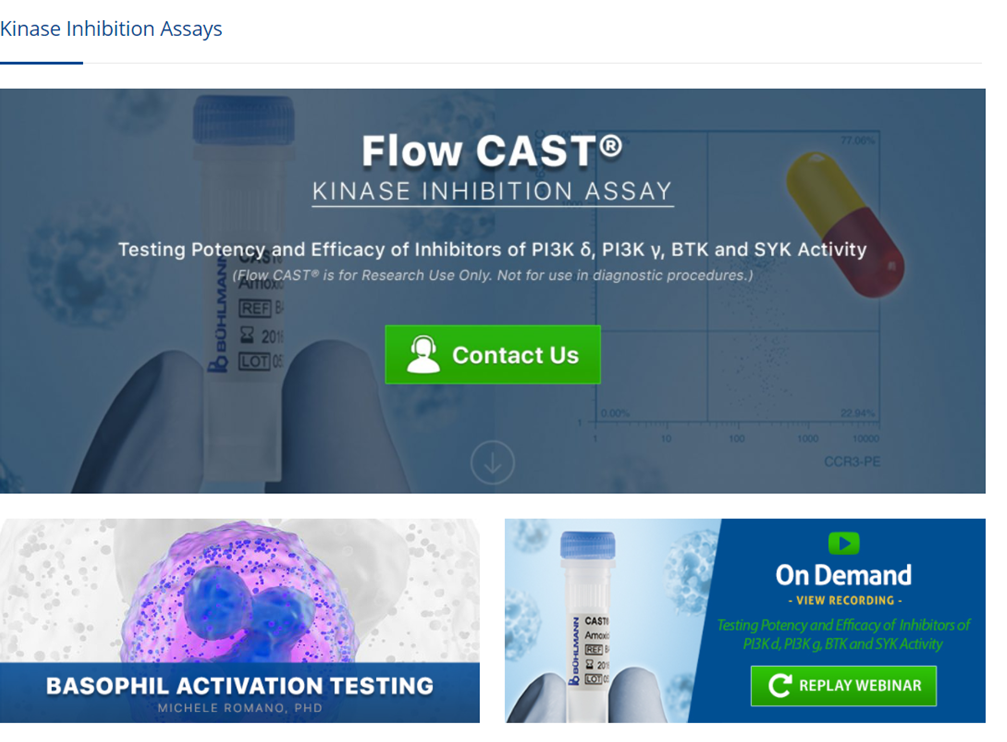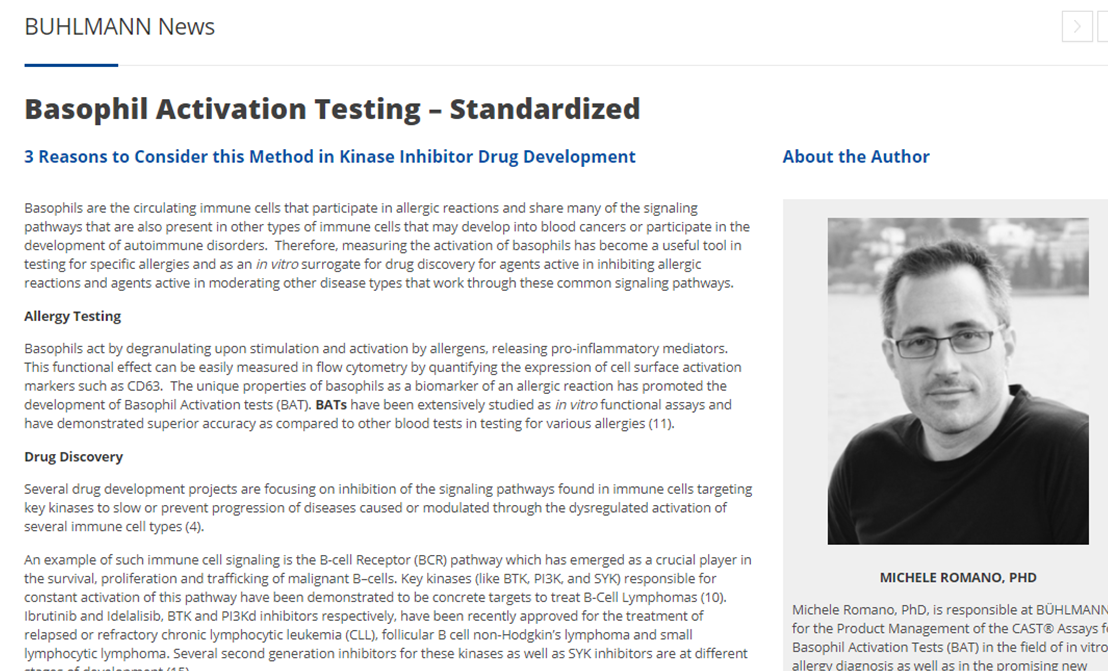
basophil-activation
CAST® is the standardized, proven & assessable Basophil Activation Test Portfolio.
An accurate biomarker of an allergic reaction… in a vial.

Flow CAST® is for Research Use Only in the US. Not for use in diagnostic procedures.
Stimulation Buffer and Allergen is added to EDTA whole blood from individuals. The allergen mimics the in vivo reaction where specific IgE bound to the cellular surface are bridged by the culprit allergen and activates an intracellular signaling cascade leading to the activation of the basophil. As a consequence, intracellular compounds bearing the transmembrane protein CD63 are fused to the cellular membrane and therefore exposed to the extracellular matrix. As positive control, highly specific monoclonal antibody binding to the high affinity IgE binding receptor (FcεRI) or the unspecific cell activator fMLP is used. Together with the cellular stimulation, Staining Reagent is added containing a mixture of monoclonal antibodies to human CD63 labeled with fluorescein isothiocyanate (anti-CD63-FITC) and to human chemokine receptor CCR3 labeled with phycoerythrin (anti-CCR3-PE). CCR3 is constitutively expressed on eosinophils and basophils. Erythrocytes are removed by a lysing reaction and after a short centrifugation step the cells are resuspended in Wash Buffer and analyzed by flow cytometry.
The constitutively expressed basophil chemokine receptor CCR3 is detected with a PE-fluorescence labelled monoclonal antibody (anti-CCR3-PE), making the gating of basophil cells significantly easier than with any other commercially available BAT. The cell surface activation marker CD63, is detected by a FITC-fluorescence labeled monoclonal antibody (anti-CD63-FITC), which is currently the best-validated basophil activation marker directly linked to basophil degranulation.
Two different positive stimulation controls are included with the kit: First is the Anti-Fc Epsilon R1 monoclonal Antibody (anti-FcεRI mAb), which is a highly specific mAb binding to the high affinity IgE binding receptor and mimics the bridging of the receptor caused by the allergen binding to two bound Immunoglobulin E. The second stimulation control, for unspecific cell activation is fMLP is a tripeptide causing basophil activation in a non-immunologic way. If one of those two controls shows activation of >10% basophils the sample can be regarded as evaluable; furthermore, should either of these two positive controls be negative, non-responders can be identified, versus being labeled as a false negative. Lastly, a negative control employing stimulation buffer (as background) is necessary and included within the kit protocol.
BÜHLMANN validated & standardized buffers, which include consistent and defined amounts of components such as IL-3, Calcium, heparin, et al., improves inter-lab and inter-run imprecision.
BÜHLMANN offers a broad range of quality controlled allergens and mixes which are standardized and validated for the use in the BÜHLMANN Flow CAST® and CAST® ELISA kits; find complete allergen listing here.
The CD203c is an alternative basophil activation marker to the CD63. Our CD203c Reagent Set (RUO) is intended for the use within an extended protocol for the Flow CAST® kit, allowing the measurement of both activation markers, CD63 and CD203c, with two different fluorescence labelled antibodies.
* References available upon request.
Flow CAST® (Basophil Activation Test) – FK-CCR-U
CD203c Reagent Set – B-CCR-203SET
BÜHLMANN Products are distributed in Canada by Inter Medico. For more information, email info@inter-medico.com or call 1.800.387.9643.
Flow CAST®(Basophil Activation Test) – FK-CCR
CD203c Reagent Set – B-CCR-203SET
Flow CAST Technical Flyer [EN]
Kinase Inhibition- Functional readout for drugs targeting immune cell signaling pathways: PI3Kδ, BTK, SYK
More Flow-CAST® Applications- There is more to allergy than just IgE
Flow CAST® “Development of a Robust Automated 384-well Whole Blood Flow Cytometry Assay”… Contact Sales
Product H/kinase-inhibition-assays/highlights
Kinase Inhibition Assays…Flow CAST® Support in Drug Development
3 Reasons to Consider this Method in Kinase Inhibitor Drug Development

| Method | Flow Cytometry |
| Time to result | 1 h (approx.) |
| Sample type | 50 µl EDTA whole blood |
| Marker | CCR3-PE / CD63-FITC |
| Catalog Number | see below |
| Patents | US 8,563,258 B2; EP 2 037 269 B1 |
| Status | RUO |
| Method | Flow Cytometry |
| Time to result | 1 h (approx.) |
| Sample type | 50 µl EDTA whole blood |
| Marker | CCR3-PE / CD63-FITC / CD203c-PE-DY647 |
| Catalog Number | see below |
Peanut and Tree nuts
Cottel N, et al. Two Different Composite Markers Predict Severity and Threshold Dose in Peanut Allergy. Clin Immunol Pract. 2020 Oct 7:S2213-2198(20)31092-8. https://doi.org/10.1016/j.jaip.2020.09.043. Epub ahead of print. PMID: 33038591.
Duan L., et al. Basophil activation test shows high accuracy in the diagnosis of peanut and tree nut allergy: The Markers of Nut Allergy Study. Allergy. 2020 Dec 9. https://doi.org/10.1111/all.14695 Epub ahead of print. PMID: 33300157.
Santos AF, et al.. Basophil activation test reduces oral food challenges to nuts and sesame. J Allergy Clin Immunol Pract. 2020 Dec 29:S2213-2198(20)31403-3. https://doi.org/10.1016/j.jaip.2020.12.039 Epub ahead of print. PMID: 33385591.
Sarita U. Patil, et al., Early decrease in basophil sensitivity to Ara h 2 precedes sustained unresponsiveness after peanut oral immunotherapy, Journal of Allergy and Clinical Immunology, 2019 https://doi.org/10.1016/j.jaci.2019.07.028
Santos AF. et al. : Basophil activation test discriminates between allergy and tolerance in peanut-sensitized children. J Allergy Clin Immunol. 2014 Sep;134(3):645-52. https://doi.org/10.1016/j.jaci.2012.12.1133
Rentzos et al. Use of a basophil activation test as a complementary diagnostic tool in the diagnosis of severe peanut allergy in adults. Clinical and Translational Allergy (2015) 5:22. https://doi.org/10.1186/s13601-015-0064-9
Santos AF. et al. Distinct parameters of the basophil activation test reflect the severity and threshold of allergic reactions to peanut. J Allergy Clin Immunol. 2015 Jan;135(1):179-86. doi: 10.1016/j.jaci.2014.09.001.
Song et al, Correlations between basophil activation, allergen-specific IgE with outcome and severity of oral food challenges. Ann Allergy Asthma Immunol 114 (2015) 319e326. https://doi.org/10.1016/j.anai.2015.01.006
Teodorowicz M. et al, Immunological Characterization of Dutch Sesame Seed-Allergic Patients. Int Arch Allergy Immunol 2016;169:13–22. https://doi.org/10.1159/000443641
Lötzsch et al. Exploratory analysis of CD63 and CD203c expression in basophils from hazelnut sensitized and allergic individuals. Clin Transl Allergy (2016) 6:45 DOI 10.1186/s13601-016-0134-7
Cow Milk & Egg
Ruinemans‐Koerts, et all.. The Basophil Activation Test reduces the need for a food challenge test in children suspected of IgE‐mediated cow’s milk allergy. Clin Exp Allergy. 2019; 49: 350– 356 https://doi.org/10.1111/cea.13307
Rubio A, et al. Benefit of the basophil activation test in deciding when to reintroduce cow’s milk in allergic children. Allergy. 2011 https://adc.bmj.com/content/93/Suppl_2/p114
Gamboa PM, et al. Is the Quantification of Antigen-Specific Basophil Activation a Useful Tool for Monitoring Oral Tolerance Induction in Children With Egg Allergy? J Investig Allergol Clin Immunol. 2016;26(1):25-30. PMID: 27012013
Berin MC, et al. Egg-specific IgE and basophil activation but not egg-specific T-cell counts correlate with phenotypes of clinical egg allergy. J Allergy Clin Immunol. 2018 Jul;142(1):149-158.e8. https://doi.org/10.1016/j.jaci.2018.01.044
Sato S, et al.. Basophil activation marker CD203c is useful in the diagnosis of hen’s egg and cow’s milk allergies in children. Int Arch Allergy Immunol. 2010;152 Suppl 1:54-61. doi: 10.1159/000312126
Nucera E, et al. Utility of Basophil Activation Test for monitoring the acquisition of clinical tolerance after oral desensitization to cow’s milk: Pilot study. United European Gastroenterol J. 2015 Jun;3(3):272-6. doi: 10.1177/2050640615570694. PubMed PMID: 26137302
Other Food
Mehlich J, et al. The basophil activation test differentiates between patients with alpha-gal syndrome and asymptomatic alpha-gal sensitization. J Allergy Clin Immunol. 2019 Jan;143(1):182-189. doi: 10.1016/j.jaci.2018.06.049
Kalic T, et al. Patients Allergic to Fish Tolerate Ray Based on the Low Allergenicity of Its Parvalbumin. J Allergy Clin Immunol Pract. 2019 Feb;7(2):500-508.e11. doi: 10.1016/j.jaip.2018.11.011. Epub 2018 Nov 22. PubMed PMID: 30471362.
Shan D. et al. , Clinical utility of basophil activation test in diagnosis and predicting severity of mugwort pollen-related peach allergy, World Allergy Organization Journal, Volume 12, Issue 6, 2019, 100043. https://doi.org/10.1016/j.waojou.2019.100043
Soh JY, et al. Anaphylaxis to galacto-oligosaccharides–an evaluation in an atopic population in Singapore. Allergy. 2015 Aug;70(8):1020-3. doi: 10.1111/all.12645.
Review
Ru-Xin Foong, et.al., Improving Diagnostic Accuracy in Food Allergy,The Journal of Allergy and Clinical Immunology: In Practice, Volume 9, Issue 1,2021, Pages 71-80, ISSN 2213-2198, https://doi.org/10.1016/j.jaip.2020.09.037.
Santos AF, et al. Biomarkers of severity and threshold of allergic reactions during oral peanut challenges. J Allergy Clin Immunol. 2020 Aug;146(2):344-355. https://doi.org/10.1016/j.jaci.2020.03.035 Epub 2020 Apr 18. PMID: 32311390; PMCID: PMC7417812
Patil SU, et.al. Emerging Food Allergy Biomarkers. J Allergy Clin Immunol Pract. 2020 Sep;8(8):2516-2524. doi: 10.1016/j.jaip.2020.04.054. PMID: 32888527; PMCID: PMC7479640.
Eiwegger, T., Hung, L., San Diego, K. E., O’Mahony, L., & Upton, J. (2019, December 1). Recent developments and highlights in food allergy. Allergy: European Journal of Allergy and Clinical Immunology. https://doi.org/10.1111/all.14082
Santos AF, Shreffler WG. Road map for the clinical application of the basophil activation test in food allergy. Clin Exp Allergy. 2017 Sep;47(9):1115-1124 https://doi.org/10.1111/cea.12964